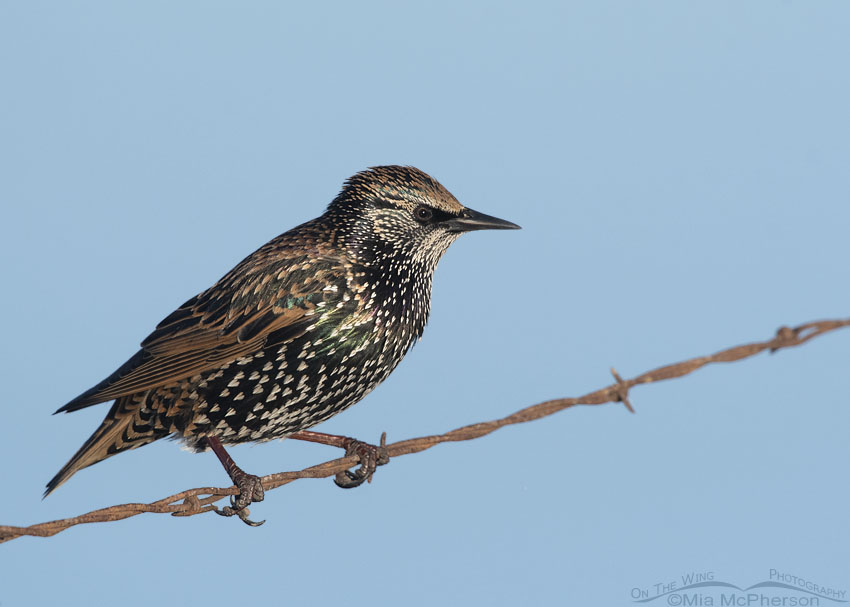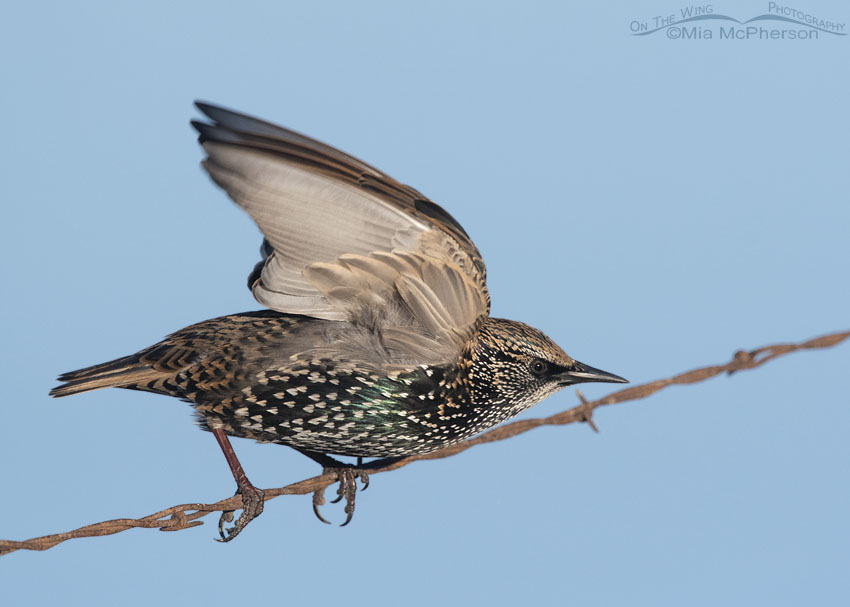 European Starling perched on rusty barbed wire – Nikon D500, f7.1, 1/3200, ISO 800, +0.3 EV, Nikkor 500mm VR with 1.4x TC, natural light
European Starling perched on rusty barbed wire – Nikon D500, f7.1, 1/3200, ISO 800, +0.3 EV, Nikkor 500mm VR with 1.4x TC, natural light
I know that there are people who find European Starlings repulsive and resent them for being in this country. I don’t. I feel that if there is something or someone to blame for their introduction it points directly to humans and homesick European settlers to this country that wanted to see familiar birds.
Personally I am fascinated by European Starling murmurations, their interesting, beautiful plumage and how they can mimic the calls and songs of other birds. Like all the other wild birds in this country I will happily photograph them when I have the chance.
I photographed this European Starling last week next to Glover Pond near Farmington Bay WMA on rusty barbed wire where it perched along with Red-winged and Brewer’s Blackbirds.
 European Starling lifting off from rusty barbed wire fence – Nikon D500, f7.1, 1/3200, ISO 800, +0.3 EV, Nikkor 500mm VR with 1.4x TC, natural light
European Starling lifting off from rusty barbed wire fence – Nikon D500, f7.1, 1/3200, ISO 800, +0.3 EV, Nikkor 500mm VR with 1.4x TC, natural light
Morning light can sure make the green and purple iridescence in their feathers glow.
I thought I’d share some facts and information about European Starlings this morning along with my photos.
- European Starlings are small, chunky black birds with short tails, triangular wings, sharply pointed bills and have a purple and green iridescence to their feathers. European Starlings have white spots during the winter and they are glossy during the breeding season.
- Northern European Starlings migrate.
- European Starlings are nonnative and were introduced in the early 1890’s, about 100 birds were released in what is today’s Central Park in New York City, they number in the 200 million range today.
- An individual European Starling can mimic up to 20 other bird species.
- European Starling preferred habitats include cities, farmlands, ranches, suburban areas, parks and golf courses.
- European Starlings eat fruits, plants, seeds, insects, small vertebrates, spiders and earthworms.
- European Starlings lay 4 to 8 eggs which hatch in 12 to 14 days. Both sexes incubate and they are monogamous.
- A group of European Starlings can be called a “filth”, “vulgarity”, “scourge”, “murmuration” and “constellation” of starlings.
- European Starlings can live to be more than 15 years of age.
Life is good.
Mia
Click here to see more of my European Starling photos.


Excellent shots to go along with your very interesting narrative. Thanks Mia.
Beautiful as always, Mia. The Shakespeare bit is a myth, though: there is no evidence whatsoever.
Sigh on the technological woes.
Love the starlings and agree wholeheartedly. People are responsible for their presence.
And how I would LOVE to see a murrmuration.
Sorry to hear about your electronic woes..starling photos are great…they arrive here with grackles and redwinged bkack birds…I think the males may arrive first. I just git a new lhone, a smart phone…but wish to heck I’d gotten a flip phone agsin…if youbwant to sell yours, let me know…
Starlings are very intelligent. We had an imprinted starling and it was interesting watching it try various problem solving tasks we gave it. It would also take cues from humans similar to how dog will. Plus I think they are an attractive bird.
Sorry about the electronics. I am in a similar situation on this trip. My laptop broke so I can’t view my photos. I don’t know if is repairable. I might have to buy anew one.
Sorry to hear about your phone Mia but at least we have these beautiful images of Starlings. I am in agreement with you and find there murmations mesmerizing. I’d rather see these beautiful birds than pythons in Florida, all due to humans.